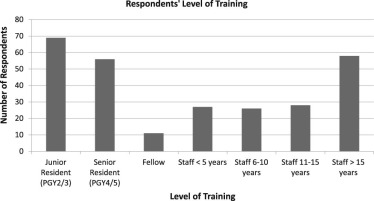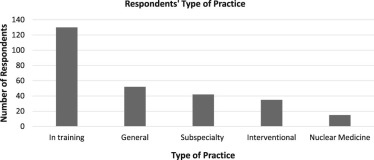Rationale and Objectives
Recently, the relevance of the postgraduate year 1 (PGY-1) Basic Clinical Year for radiology residents has been questioned. The purpose of this study was to determine the attitude of radiologists and trainees toward this year and which clinical rotations they perceived as most valuable to clinical practice.
Materials and Methods
Following institutional review board approval, an anonymous online survey was administered to Canadian radiologists and radiology trainees. In addition to reporting demographic information, respondents were asked to rank the usefulness of individual rotations on a five-point Likert scale. To assess whether there are differences in the ratings and therefore rankings of the rotations by gender, position, and level of training, the Kruskal-Wallis one-way analysis of variance test was used with significance defined as P < .05. The Schulze method was used to rank the perceived usefulness of clinical rotations considered.
Results
Of the 275 respondents, 73.1% were male and 47.3% were trainees. A total of 71.3% of respondents were in favor of the basic clinical year, whereas 16.4% opposed. There was a statistically significant difference between the responses of staff radiologists and trainees, with the staff more strongly favoring the Basic Clinical Year (84.1%) than the trainees (56.9%) ( P < .0001). As a whole, the respondents favored general surgery rotations as most relevant to their clinical practice (agreement rate of 48.3%). Interventional radiologists found general and subspecialty surgical rotations to be equally relevant. The rotations deemed to be “essential” were emergency medicine (48.7%) and general surgery (46.6%), and the rotations deemed to be “very useful” were orthopedics (45.8%), trauma (44.4%), neurosurgery (43.3%), neurology (42.2%), and hepatobiliary surgery (38.9%). There was no statistical difference between the respondents’ choices based on their level of experience and scope of practice.
Conclusions
Most radiologists and radiology trainees were in favor of completing the PGY-1 Basic Clinical Year. However, programs should maximize the education value of this year by including more of the top-ranked rotations. As the practice of radiology evolves, it is important to ensure that training paradigms continue to prepare residents for independent practice.
Introduction
The last decade in radiology has been defined by the introduction of new technology and increased specialization, which are reflected in resident education. Most recently, the subspecialty of Interventional Radiology has become its own direct entry residency program in the United States, altering the traditional training of radiologists. In Canada, although interventional radiology is now an accredited residency program, interested residents must first complete a diagnostic radiology residency . Residency programs must ensure that residents are adequately prepared to meet the current needs of clinical practice. One aspect of radiology residency training that has been under scrutiny is the postgraduate year 1 (PGY-1). The value of this year, as it is currently offered to residents, has been a topic of debate in the literature, with opponents arguing that it has no additional value to trainees and that more time should be spent focusing on learning radiology .
In North America, the first year of Diagnostic Radiology Residency training is the Internship or Transitional Year (United States) or Basic Clinical Year (Canada). In American programs, residents can select between a surgical and a medical internship; whereas in Canadian programs, this year is determined by the institution at which the resident will be completing their radiology training. American residents also have the opportunity to complete a Transitional Year, which is more similar to the Canadian Basic Clinical Year as residents rotate through several disciplines; however, most American radiology residents still opt to complete a traditional internship . In Canada, radiology programs were not responsible for this PGY-1 Basic Clinical Year until the introduction of the Canadian Residency Matching Service in the early 1990s . Since this time, the structure of the PGY-1 Basic Clinical Year for Royal College Specialty Programs in Canada has not significantly changed despite the evolution of the speciality during this same time . Given the rapid growth in radiology, it is important to evaluate the educational value of the PGY-1 Basic Clinical Year to ensure that trainees are receiving maximum value from their training programs. There have been no studies assessing the perceived educational value of the basic clinical year for radiology trainees.
Get Radiology Tree app to read full this article<
Get Radiology Tree app to read full this article<
Materials and Methods
Participant Recruitment
Get Radiology Tree app to read full this article<
Survey Content
Get Radiology Tree app to read full this article<
Statistical Analysis
Get Radiology Tree app to read full this article<
Results
Demographic Data
Get Radiology Tree app to read full this article<
Get Radiology Tree app to read full this article<
Overall Attitude Toward the Basic Clinical Year
Get Radiology Tree app to read full this article<
Get Radiology Tree app to read full this article<
Most Important Clinical Rotations
Get Radiology Tree app to read full this article<
TABLE 1
Rotations Ranked as “Essential” and “Very Useful” by Respondents
Rotations Selected as Essential Rotations Selected as Very Useful Emergency Medicine (48.7%) Orthopedics (45.8%) General Surgery (46.6%) Trauma (44.4%) Neurosurgery (43.3%) Neurology (42.2%) Hepatobiliary Surgery (38.9%)
Get Radiology Tree app to read full this article<
Get Radiology Tree app to read full this article<
TABLE 2
The “Ideal” Basic Clinical Year Includes the Top 13 Ranking Clinical Rotations
The “Ideal” Basic Clinical Year for Diagnostic Radiology Residents 1. Emergency medicine 8. Gynecology \* 2. General surgery 9. Hepatobiliary surgery \* 3. Orthopedics 10. Intensive care \* 4. Trauma 11. Oncology 5. Neurosurgery 12. Pulmonology 6. Neurology 13. Pathology 7. General Internal Medicine
Get Radiology Tree app to read full this article<
Get Radiology Tree app to read full this article<
Get Radiology Tree app to read full this article<
Get Radiology Tree app to read full this article<
Discussion
Get Radiology Tree app to read full this article<
Get Radiology Tree app to read full this article<
Get Radiology Tree app to read full this article<
Get Radiology Tree app to read full this article<
Get Radiology Tree app to read full this article<
Conclusions
Get Radiology Tree app to read full this article<
Appendix 1
Get Radiology Tree app to read full this article<
TABLE A1
The 31 Rotations Ranked by the Schulze Method
1. Emergency medicine 17. Rheumatology 2. General surgery 18. Cardiology 3. Orthopedics 19. Pediatric surgery 4. Trauma 20. Cardiac surgery 5. Neurosurgery 21. Transplant medicine 6. Neurology 22. Nephrology 7. General Internal Medicine 23. Infectious diseases 8. Gynecology \* 24. Plastic surgery 9. Hepatobiliary surgery \* 25. Anesthesia 10. Intensive care \* 26. Subspecialty pediatrics 11. Oncology 27. Endocrinology 12. Pulmonology 28. Ophthalmology 13. Pathology 29. Hematology 14. ENT 30. Public health 15. General pediatrics 31. Palliative care 16. Obstetrics
ENT, ear, nose, and throat.
Get Radiology Tree app to read full this article<
Get Radiology Tree app to read full this article<
References
1. The Royal College of Physicians and Surgeons of Canada (RSCPC) : Subspecialty Training Requirements in Interventional Radiology.2014.
2. Gunderman R.B., Tobben J.P.: Is it time to jettison radiology’s clinical year requirement?. Acad Radiol 2016; 23: pp. 389-391.
3. Pfeifer C.M.: Evolution of the preliminary clinical year and the case for a categorical diagnostic radiology residency. J Am Coll Radiol 2016; 13: pp. 842-848.
4. Royal College of Family Physicians : College History. Available at http://www.cfpc.ca/CollegeHistory/
5. The Royal College of Physicians and Surgeons of Canada (RCPSC) : Speciality Training Requirements in Diagnostic Radiology.2014.
6. The R Foundation : The R Project for Statistical Computing. Available at https://www.r-project.org/
7. Baker S.R., Tilak G.S., Geannette C., et. al.: The value of the internship year for radiologists: a retrospective analysis as assessed by current residents and fellows. Acad Radiol 2008; 15: pp. 1205-1210.
8. Darras K.E., Worthington A., Russell D., et. al.: Implementation of a longitudinal introduction to radiology course during internship year improves diagnostic radiology residents’ academic and clinical skills: a Canadian experience. Acad Radiol 2016; 23: pp. 848-860.
9. Jambhekar K., Meek M.E., Major V., et. al.: Radiology boot camp: facilitating the transition of interns into residents. J Am Coll Radiol 2014; 11: pp. 329-331. e1
10. The Royal College of Physicians and Surgeons of Canada (RSCPC) : Competency by Design: The Royal College of Physicians and Surgeons of Canada. Available at http://www.royalcollege.ca/rcsite/competence-design-e

